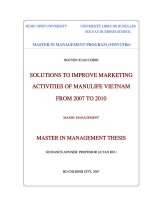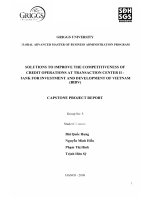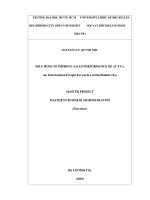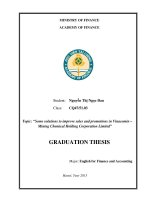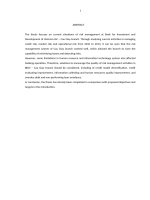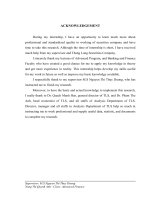Solutions to improve sales performance of Act Co. (an International Freight Forwarder in Hochiminh City)
Bạn đang xem bản rút gọn của tài liệu. Xem và tải ngay bản đầy đủ của tài liệu tại đây (728.77 KB, 73 trang )
TRNG I HC M TP. HCM UNIVERSITE LIBRE DE BRUXELLES
HOCHIMINH CITY OPEN UNIVERSITY SOLVAY BRUSSELS SCHOOL
MBAVB2
NGUYEN LUU QUYNH NHU
SOLUTIONS TO IMPROVE SALES PERFORMANCE OF ACT Co.
(an International Freight Forwarder in Hochiminh City)
MASTER PROJECT
MASTER IN BUSINESS ADMINISTRATION
(Part-time)
Ho Chi Minh City
(2010)
DECLARATION
I declare that the work contained in this master project was performed by
me under the supervision of Dr. Nguyen Van Ngai.
Any data, quote, reference in this project are clearly identified.
ACKNOWLEDGEMENTS
I would like to thank Solvay Brussels School (SBS) and Open University
of Hcmc for giving me this opportunity to perform and complete my MBA. I
would like to thank all Professors of SBS for their teaching and good lessons
through this course of MBAVB2 (2007-2009).
I would like to thank Dr. Nguyen Van Ngai for his guidance and
enthusiasm through this Project.
I would like to thank to ACT Co. for the necessary data that helps me
fulfil this final project.
I would like to thank my friends at MBAVB2 class, especially Van’s
group, Juice’s group for supporting me through the course.
TABLE OF CONTENT
LIST OF TABLES
LIST OF CHARTS
LIST OF ABBREVIATIONS
EXECUTIVE SUMMARY 1
Chapter 1: INTRODUCTION
1.1 Statement of the Problem 5
1.2 Objectives of the Study 7
1.3 Scope and limitations of the Study
7
1.4 Methodology 7
1.5 Structure of the Study 8
Chapter 2: LITERATURE REVIEW
2.1 Theory of 25 Sales Strategy 10
2.2 Other Studies 18
2.3 Research framework 21
Chapter 3: INTRODUCTION OF AMERICA EUROPE CARGO (ACT)
3.1 Logistics service industry overview 22
3.2 Introduction of ACT Co., Ltd 23
3.2.1 Company history 23
3.2.2 Company’s vision, mission and core value 24
3.2.3 ACT’s Organization 25
3.2.4 Main activities at ACT Co. and their basic processes 26
3.2.4.1 Export 26
3.2.4.2 Import 28
3.2.4.3 Customs Clearance 29
3.2.4.4 Inland trucking 29
3.2.5 ACT’s customers & Competitors 29
3.2.6 Current situation of ACT’s sales performance via secondary data
30
Chapter 4: SALES STRATEGIES
4.1 Current 25 sales strategies at ACT Co. 32
4.2 Solutions to improve sales performance 44
4.2.1 Build a better rapport with customers 44
4.2.2 Understand the Customer’s Needs 45
4.2.3 Creative Selling 48
CONCLUSIONS 50
REFERENCES
APPENDIX
LIST OF TABLES & CHARTS
Table 2.1: 25 Sales Strategies 10
Table 3.1: Sales & Profits performance through years 29
Table 4.1: 3PL selection criteria of customers 33
Table 4.2: Descriptive Statistics 35
Table 4.3: Export customers’ information 36
Table 4.4: Key answers of customers via in-depth interviews 37
Table 4.5: Profits & Sales calculation 47
Chart 3.1: Top five outsourcing logistics activities 21
Chart 3.2: ACT’s Organization 24
Chart 3.3: ACT’s sales performance through years 30
Chart 4.1: Buying Criteria 34
LIST OF ABBREVIATIONS
ACT : America Europe Cargo Co., Ltd
20’DC : Twenty-feet dry container
40’DC : Forty-feet dry container
40’HC : Forty-feet high cube container
FCL : Full Container Load
LCL : Less-than-Container Load
B/L : Bill of Lading
GDP : Gross Domestic Products
AWB : Airway bill
D/O : Delivery Order
3PL : Third-party logistics
CIF : Cost, Insurance & Freight
CNF : Cost & Freight
FOB : Free on board
P.I.C : Person In Charge
SGN : HOCHIMINH CITY
ROT : ROTTERDAM
FLX : FELIXSTOWE
BOS : BOSTON
LAX : LOS ANGELES
PUS : PUSAN
1
EXECUTIVE SUMMARY
During recent decades, needs of logistics service have been increasing.
Entrustment with logistics service to logistics service provider has become a
solution of majority of enterprises.
America Europe Cargo Co. (ACT Co., Ltd) is an international freight
forwarding company (brief as forwarder) in Hochiminh City that provides service
of international cargo transportation by sea (ship by sea), by air (ship by
airplane), customs clearance, inland haulage. All of these services are some
main activities of logistics service. Years of 2008, 2009 and 2010 were assessed
at the hard years for ACT as its sales had declined (falled more than 12%-16% in
comparison with previous years from 2005 to 2007 which sales increased
gradually each year) resulting its profit declined correlatively. Beside the tough
competition among freight forwarders and logistics service providers in Vietnam,
main reasons for these sales decline are some important customers have left the
company and some used the company’s shipping service less than before. In
order to understand why customers have no longer or less used ACT’s service
than before and how they have assessed the service recently, surveys via
questionnaires and in-depth interview were made, some important points were
found as follows:
Based on survey respondents, four main factors affect to customers in
choosing one shipping service are: good rates (price), good customer service
(polite, professional, enthusiastic, flexible, fast (feed back)), close relationship
2
and credit period. Through this survey, customers commented that they didn’t
satisfy ACT’s service with factors: Price, Credit term and Commission policy.
From the in-depth interviews, all of 10 interviewees presented for ACT’s
major customers would care for lowest rates, long credit period, high
commission, close relationship. Besides, they suggested that ACT should provide
integrated solutions across the supply chain, that means ACT should add more
service as a contract logistics (warehouse and logistics space) to be good choice
for logistics outsourcing.
In order to keep the current customers, increase their times of service uses
and generate new customers, several solutions to improve sales performance of
ACT are suggested as follows:
(1) Build a better rapport with customers
Frequent communication and various types of messages sent to customers
are very necessary ways to tighten the relationship with them. It’s possible to
combine email, phone contact and face-to-face communication, etc.
First, create customer database and contact them on a regular basis;
discover customer’s interests and share with them. Invite customers to go out for
coffee, dinner, take them to a ball game, a concert or golfing.
Second, offer customer with rewards to remind them of the company and
services. This way could help build better relationship with customers.
Third, build two-way communication: send surveys to customers (online or
offline). This makes customers feel they are listened by the company.
3
(2) Understand the customers’ needs
There are many ways to better understand customers’ needs: ask them
directly, send them a customer satisfaction survey, periodically invite customers
to lunch or dinner.
Via the questionnaire survey, ACT’s customers are looking for:
competitive rates, credit offer, high commission. And from the in-depth
interviews, they are looking for more services from ACT Co. such as
warehousing, packaging or whole package service. In order to adapt with these,
ACT must lower rates; offer credits and consider highest possible commission to
regular customers.
(3) Sell creatively (creative selling)
The classical selling is used by many companies. If this way of selling
doesn’t work much for ACT, ACT must find other ways, even uncommon ways
to reach new and potential domestic and international customers:
Send everyday hundreds or thousands of business co-operation emails to
overseas agents (overseas forwarders) who are found from some famous Freight
Directory to seek more seafreight, airfreight inquiries from them.
Contacts directly with Vietnamese suppliers on Alibaba website for export
shipments or Vietnamese buyers for import shipments. Try to contact with them
by sending emails or chat with them via some chat programs.
Sells overseas by contacting with foreign customers from international
trading websites: Alibaba website…
4
Join in one or two international freight forwarding associations such as
WCA, APLN, Freightnet to exchange business and create chances to get
nominated shipments from overseas partners.
5
Chapter 1
INTRODUCTION
Logistics plays an important role for the production of a business sector
and an economy though rather new for many people inVietnam. Under the Trade
Law of Vietnam in 2005, logistics is a commercial activity by traders or
organizations make one or many stages including receiving, transporting,
warehousing, customs clearance and many types of documents, packaging,
delivery and other services related to goods entitled to charge remuneration. In
Vietnam, the logistics industry is still a new but in the world it has been longtime
active service with many groups work with global scale such as: Maersk
Logistics, Mitsui Logistics, APL Logistics, Kuehne-Nagel. The characteristic of
Logistics is a close cycle from warehouse to end consumers. International freight
forwarding service is one of main activities of Logistics service (including
warehousing service, international freight forwarding service, inland haulage,
customs clearance, etc.). As a whole, Vietnamese enterprises in the international
freight forwarding and logistics industry just perform freight forwarding service
as one of many logistics service chains. This is the simple form when freight
forwarding companies play a role to buy freight rate from carriers and resell it to
their customers (exporter or importer) to get a margin between the selling rate
and buying rate.
1.1 STATEMENT OF THE PROBLEM
Roles of freight forwarding have been acknowledged very clearly in the
globalization trend nowadays. Freight forwarding creates good conditions for fast
6
circulation of goods. With freight forwarding and logistics service, trading and
producing enterprises can save their time a lot and concentrate more on their
business such as expanding new products, entering other markets. Market
economy developed, goods exchanged among countries have increased quickly.
Since competition of price among manufaturers is narrowing with every passing
day, manufacturers have switched to the speed competition from freight
forwarding aspect. Hence, freight forwarders and logistics companies have
chances to develop their business stronger. International freight forwarders and
logistics providers have increased to meet the needs of transporting cargo from
producing places to end places of consumption. Along with the development of
import-export activities in Vietnam, more and more international freight
forwarders found. This has caused fierce competition among freight forwarding
companies in Vietnam.
America Europe Cargo Co., Ltd (ACT) established in 2004 is an
international freight forwarder in Hochiminh City. ACT’s providing main service
of international cargo transportation by sea and air from Vietnam to worldwide
and vice versa.
Three years recently (2008, 2009 and 2010), ACT saw more than 10% -
16% decline in sales and correlatively profits were declined. Looking at just
three years from 2005 to 2007, sales increased gradually each year from 10.73%
to 14.4%. But in 2008, it fell 12.92% (sales reached only Usd 1,311,668 in
comparison with Usd 1,506,332 in 2007), 16% in 2009 (sales of Usd 1,100,866)
and 10.13% in 2010 (sales amount of Usd 989,331 in comparison with Usd
1,100,866 in 2009). Reasons for these declines came from some important
7
customers have left the company and times of using shipping service were less
than before.
These declines have made Director of the company look solutions for
sales improvement with hope to keep good growth rates in coming years: How to
keep the current customers with the company? How to increase their times of
service uses? And how to generate new customers for the company?
1.2 OBJECTIVES OF THE STUDY
Objectives of the study are to analyze the current situation at ACT company and
propose solutions to improve sales performance.
1.3 SCOPE AND LIMITATIONS OF THE STUDY
This project discusses key issue of how ACT’s sales declined in three
recent years from 2008 to 2010 and solutions to improve sales performance in
coming years are raised.
Through the major factors have been discussed, there are more issues
which still have not been details due to time contraints. Mode of cargo transport
mentioned in this project is mainly focused on containers shipping by sea and for
export shipments only due to main sales from ACT are from handling export
shipments. Import shipments have just made up small part in the total sales.
1.4 METHODOLOGY
Descriptive statistical and data analysis are used in this project.
8
Questionnaire was designed and delivered via emails to sixty ACT’s big
customers in order to clarify more about which criteria for them to select an
international transport service and how they assessed ACT’s service, from that
ACT would give some solutions to adapt with. Forty-five respondents returned
but only forty (40) ones were complete and valid for data analysis. Based on
what survey respondents’ assessment on ACT’s service, descriptive statistics
analysis was used on Excel with several criteria of Price, Commission, Credit
period, Fast feedback, Customer service, Equipment availability, Reputation,
Satisfaction with Min, Max, Mean, Standard Deviation. Besides the survey via
questionnaires, in-depth interviews were arranged with ten ACT’s regular
customers at their offices. Based on the discussion guideline, eight open
questions were asked to understand deeply the customers’ needs and
expectations from ACT.
The analysis is also based on secondary data from internal and external
sources (desk research): annual reports of ACT through years (2005-
2010)(internal data) and SCM research relating to logistics activities in 2008
(external data).
1.5 STRUCTURE OF THE STUDY
This project includes four chapters:
Chapter 1 shows the problem of the company; objectives, scope and
limitations of the study, methodology and structure of the study.
Chapter 2 introduces a sales strategy matrix which was designed to
present 25 sales strategies written by Peter R. Garber (2007) in relation to two
critical factors concerning selling to customers – relationship and performance.
9
In an update to the study of sales strategy, four other studies with keys to
keep and create sales were selected to review and officially state that no study at
ACT on this sales strategies was made before.
Chapter 3 presents the sector review, ACT’s history, organization, main
activities, customers, competitors and current situation of ACT’s sales
performance.
Chapter 4 analyzes in details each strategy that are supported with
questionnaire survey and in-depth interview’s results to find out which strategies
ACT should concentrate on among 25 strategies. Several solutions to improve
sales performance of ACT Co. are presented here also.
10
Chapter 2
LITERATURE REVIEW
2.1 THEORY OF 25 SALES STRATEGIES
There are a lot of literatures on sales strategies such as “101 Successful
Sales Strategies” (Stephan Schiffman, 2005), “25 Sales Strategies and
Activities” (Peter R. Garber, 2007), etc. Each of them grants some significant
contributions to the understanding more about sales activities in a company.
Increasing sales is always a main concern for any company doing
business, especially for companies which have been facing with declined sales
issue. To improve this situation, many sales strategies were introduced by
famous economists, business consultants.
After a thorough review of some books on sales strategies, the book of
“25 Sales Strategies and Activities” written by Peter R. Garber (2007) is used as
an useful reference guide and resource. This book provides a Sales Strategy
Matrix that can be used in many different ways. The matrix is designed to
present each of the 25 sales strategies in relation to two critical factors
concerning selling to customers – relationships and performance.
On this matrix, the position of each strategy shows how much it
emphasizes both relationship and performance. As shown on the vertical axis of
the matrix, the relationship index is measured from highest at the top to lowest at
the bottom. Relationships deal with how the customer perceives company as a
supplier based on past experience and interactions with the company. Similarly,
11
the performance index is shown on the horizontal axis as highest to the right and
lowest to the left. Performance for this purpose is more focused on what
company as a supplier actually deliver to the customer. Strategies on the matrix
are further classified as highest, higher, moderate, lower, lowest.
Table 2.1: 25 Sales Strategies
Source: Peter R. Garber (2007), 25 Sales Strategies and Activities
Belows are summaries of 25 sales strategies as listed in the book:
Strategy 1: Know the customer
This strategy is almost entirely focused on building on company’s relationship
with the customer. Knowing the customer is important to virtually every one of
the other 24 strategies. It can also be critical to determining which other sales
12
strategies the company might want to develop with customers. Selecting Know
the customer does not diminish company’s need to perform to the customer’s
expectation.
Strategy 2: Build Rapport
Building rapport with a customer can be the most important factor in their buying
decision-making process. Without this rapport with the customer, there is far less
chance of understanding each other’s needs and how these can be met through
company’s business relationship together.
Strategy 3: Honesty is the Best Policy
Honesty is the Best Policy is really less of a sales strategy as it is a guiding
principle for dealing with customers. It appears where it does on the matrix
because it forms the core or center for company’s relationship with the customer.
It is not directly linked to performance, but certainly has an influence.
Strategy 4: Understanding the Customer’s Perspective
Understanding the customer’s perspective helps company be better prepared to
both build a stronger relationship as well as improve the performance as
perceived by the customer.
Strategy 5: Selling the “Sizzle”
Company wouldn’t use this strategy in a circumstance in which either
relationship or performance would be a critical or determining factor for the
13
customer. The type of situation in which company could use this strategy might
be when these factors are less important to making the sale.
Strategy 6: What’s in a Name?
This strategy is focused on building company’s relationship with the customer.
Names can open doors for company that would otherwise remain closed. Part of
company’s business goals should be to learn as many of company’s customers’
organizations’ names as possible, or at least know where to access this important
information. Names of products, processes, policies, materials, principles, etc.
that are important to customer should also be of great interest to the company.
Strategy 7: Selling Up, Down, All Around
This strategy is based on the belief that often it is as important who a company
know as it is what company know. Often, regardless of how good a service or
product is that company has to offer, if company doesn’t make sales presentative
to the right people, company won’t get the business. Company needs to get the
attention of the people on many levels of the customer’s organization before a
buying decision can be made.
Strategy 8: Contingency Selling
Customers want to be assured that company can be counted on to provide
product or service without interruption for as long as they want.
Strategy 9: Creating the Need
14
This strategy is lower on both the relationship and performance indexes because
it focuses on something external to both the supplier and the customer. Creating
the need does not mean that company should sell something to the customer that
they do not need. Rather, this sales strategy is really more of an education
process in which help customers understand how they can benefit from buying
company’s product or service.
Strategy 10: Having the Latest Technology
Technology can be a tremendous advantage in sales, and having the latest
technology can put company way out in front of their competition. The
technology itself will most likely address the performance aspect of what
company has to sell, again giving company a distinct advantage in this area as
well.
Strategy 11: Understand the Customer’s Needs
This strategy is focused strongly on relationships that are essential to
understanding the customer’s needs. Meeting the customer’s needs is the true
definition of quality. A sales strategy based on this objective needs to be
committed to providing the highest quality product or service possible to meet
the customer’s needs.
Strategy 12: Empowering Customers
Empowering customers requires a solid relationship and performance history be
already established with the customer. Empowerment involves trusting others to
make important decisions and to take action. Empowering the customers puts
15
him or her in control of many the decisions and actions that company might
normally control. This way the customer is not totally dependent on to get the
product or service that company provide.
Strategy 13: Cutting Costs
This strategy is positioned in the center of the matrix. Costs are so important to
the customer that they are neither solely determined by relationship nor
performance.
Strategy 14: Just-in-Time Opportunities
Just-in-time concepts have become very popular in many business applications
such as inventory control and delivery. Jus-in-time means that the product or
even service is provided at the exact time that it is needed by the customer.
Strategy 15: Pull-Through Sales
Pull-through sales is like reaching company’s goals through indirect methods.
Company achieves one thing by accomplishing something else. Pull-through
sales creates the need or demand for a particular product or service.
Strategy 16: Creating Buying Habits
16
The positioning of this strategy on the matrix emphasizes how important
relationships are to having customers continue buying from company. However,
company can depend on customer loyalty to go only so far.
Strategy 17: Selling Service
The selling service strategy focuses highly on both relationships and
performance. It would be possible to provide service that would satisfy the
customer with only a strong relationship or a strong performance.
Strategy 18: Full-Service Selling
Providing full-service selling is becoming a necessity in business today. Full-
service means that the company does as much for the customers as possible.
Customers are busy in running their own business and often value someone who
can take over certain aspects of their responsibilities. Relationships under these
circumstances are less important than actual performance. The more customers
learn to depend on one company, the less direction they need to give to this
company.
Strategy 19: Global Approach
Relationships get more complex the more global they become. Being able to
continuously and consistently provide the quality customers require on a large or
global scale can be a tremendous challenge.
Strategy 20: Value-Added Sales
17
The term value-added speaks almost entirely about performance. Value in this
case can supersede relationships. Even the strongest customer relationship can
be replaced by a value-added sales strategy.
Strategy 21: Teamwork
Developing a teamwork sales strategy with customers requires both a strong
relationship to be established plus a proven performance record. Within an
organization, employees are usually assigned to be part of a team.
Strategy 22: Adapting to Change
Change can be difficult, even a traumatic experience for customers. Helping
customers adapt to change requires to provide reassurance that they will still
receive the same quality service or product as they did before the change.
Strategy 23: Beating the Competition
Company has to be really good to beat the competition. This requires company
not only to be able to outperform competition but also to convince the customer
that company can. This challenge becomes tougher and tougher as the
competition for customers increases. This strategy focuses company to
continuously find ways to improve company’s performance to ensure that
company stays ahead of the competition.
Strategy 24: Creative Selling



